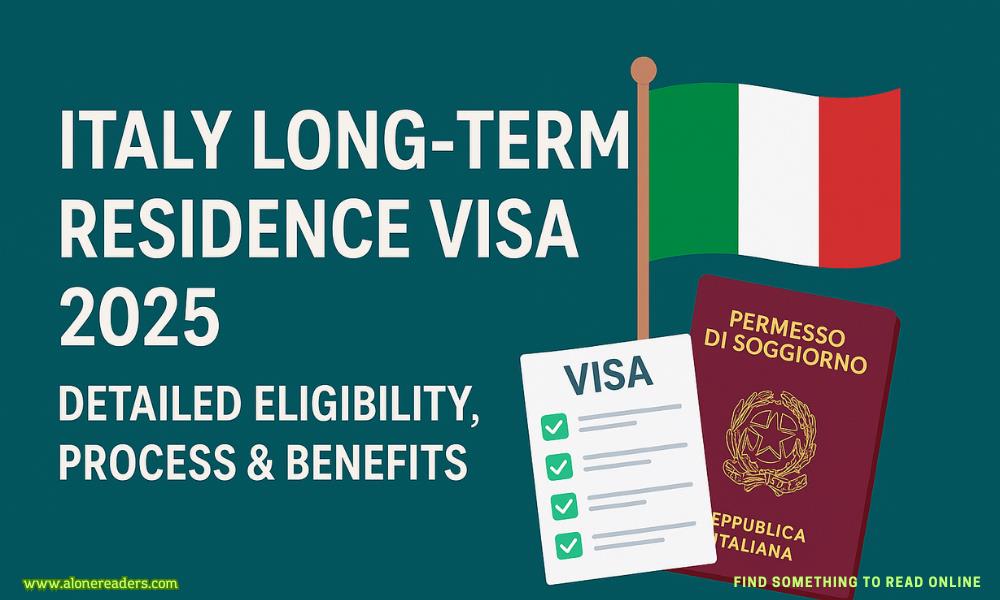
Italy’s Long-Term Residence Visa, also known as the Permesso di soggiorno UE per soggiornanti di lungo periodo, is a highly sought-after permit for non-EU nationals aiming for stable residence in the country. In 2025, this visa remains an essential path to legal integration, work freedom, and social benefits in Italy and, by extension, the European Union. But obtaining it is far from automatic. Here's a comprehensive guide to everything you need to know.
The Long-Term Residence Visa is not a traditional visa issued from outside Italy. It’s a residence permit granted after legally residing in Italy for an extended period under certain conditions. It is available to non-EU nationals who meet specific residency, income, housing, and integration criteria.
Legal Name: Permesso di soggiorno UE per soggiornanti di lungo periodo
Purpose: Grants long-term residence and mobility rights
Duration: Indefinite validity, but the physical card must be renewed every 5 years
Applies to: Non-EU nationals legally living in Italy for at least 5 years
Right to Stay Indefinitely: You will no longer be tied to your original visa (work, study, or family).
Freedom to Work or Study: You can work for any employer or start a business without additional permits.
Access to Public Benefits: This includes healthcare, education, and some social assistance programs.
EU Mobility Rights: You may live and work in other EU countries under certain conditions, often requiring you to apply for local residence within 3 months.
Family Reunification: Easier procedures for bringing family members to Italy.
To qualify for the Italian Long-Term Residence Visa in 2025, all of the following must be met:
1. Continuous Legal Stay of 5 Years
You must have held a valid residence permit for five consecutive years. The five-year period must be continuous, with only short absences allowed.
2. Stable and Regular Income
You must show income that is at least equal to the annual amount of the Italian social allowance (assegno sociale). In 2025, this is approximately €6,100/year for a single person.
3. Suitable Accommodation
You must provide proof of suitable housing that meets hygienic and safety standards set by Italian health authorities.
4. Italian Language Proficiency
Since 2011, applicants must demonstrate at least A2 level proficiency in Italian under the Common European Framework of Reference for Languages (CEFR).
5. No Criminal Record and No Threat to Public Order
Authorities assess whether you pose a security threat to Italy or the EU.
You must prepare and submit the following documents:
Step 1: Prepare Your Application Package
All supporting documents must be updated and ideally translated into Italian where required. Originals and copies are necessary.
Step 2: Submit Through Post Office (Kit Giallo)
In 2025, the application is submitted through designated post offices using the standard yellow kit (kit giallo). You’ll receive a receipt (ricevuta) and an appointment at the local immigration office (Questura).
Step 3: Biometrics and Interview at the Questura
At the appointment, you’ll be fingerprinted and interviewed. Make sure to bring originals of every document submitted.
Step 4: Wait for Processing
Processing time varies but typically ranges from 60 to 120 days. You can track your application on the Italian immigration portal using the receipt number.
Step 5: Collect Your Long-Term Residence Card
If approved, you will receive your electronic residence permit (permesso elettronico) which is valid for 5 years. The rights granted, however, are indefinite.
Additional costs may arise for translations, certifications, and housing inspection fees.
Card Renewal: The physical card must be renewed every 5 years, but the residence right remains valid indefinitely as long as conditions are met.
You May Lose the Permit If:
In such cases, your permit can be revoked or downgraded to a standard temporary permit.
Yes, but with restrictions:
This permit does not automatically allow free movement like an EU citizen enjoys but gives you more mobility than a regular visa.
While both allow permanent stay, they are not the same:
| Feature | Long-Term Residence | Italian Citizenship |
|---|---|---|
| Duration | Indefinite residence | Lifetime (with passport) |
| Voting Rights | No | Yes |
| EU Movement | Limited | Full |
| Integration Requirements | A2 level Italian | B1 level Italian, often more documentation |
| Time Required | 5 years | Usually 10 years (4 for EU nationals, 2 for Italian descendants or marriage) |
You can still apply for citizenship later even if you hold a long-term residence permit.
Final Thoughts
The Italy Long-Term Residence Visa in 2025 remains a crucial step toward stability, integration, and wider European mobility for non-EU nationals. While it involves meticulous preparation—especially in proving income, housing, and language skills—it rewards successful applicants with long-term rights and many legal protections.
Make sure to start preparing at least 6 months before your current permit’s expiration, and don’t hesitate to seek professional help for translations, housing certificates, or application reviews.
If you meet all criteria, the Permesso di soggiornanti di lungo periodo is more than just a document—it’s your ticket to permanent residence in one of Europe’s most desirable countries.